At the depths of his despair, Patrick Bines visited an injecting room. It was his only escape from agonising pain. A footy injury broke him mentally and physically. It stole his life. This is his harrowing story.
AFL has broken Patrick Bines.
It has broken his heart and broken his body.
A simple mistimed spoil to the back of his neck in 2019 — an action played out across football fields thousands of times each weekend — has changed the course of his life after a single stint with West Coast as a category B rookie.
He has had almost 20 operations and procedures on his neck that have left Bines unable to move his head without shooting, stabbing pain.
The agony is barely dulled by eight opioid pain-killing tablets each day.
At the depths of his despair, Bines — a player so anti-drugs he would leave a room if someone smoked marijuana — visited a Richmond injecting room to take morphine.
It was the only relief that would allow him to sleep after 40 relentless hours of agonising pain.
It has caused the the 22-year-old to consider whether life was worth living as he lay flat on his bed for 22 hours a day, unable to work or study or even go to the pub to celebrate friends’ 21st birthdays.
The former East Brighton junior manages each day with the support of his family, friends, and a small army that includes a therapist, psychologist, pain specialists, personal trainer, surgeon and a healing centre.
But the safety net he believed would have helped him through life broke underneath him in the most galling of circumstances.
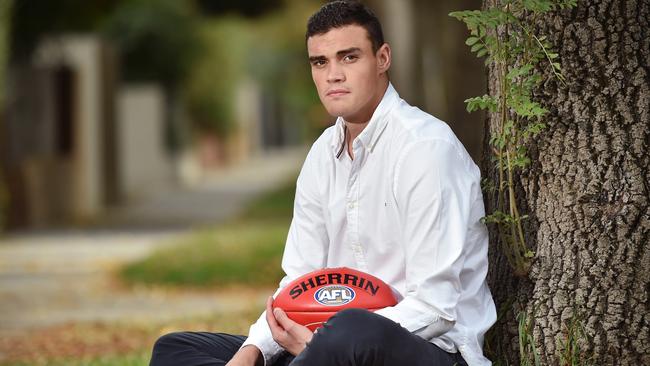
His end-of-career payout through an AFL Players Association scheme was taxed heavily and was soon gone following multiple costly surgeries, rehab and treatments.
Last week the AMP superannuation fund that he was steered into like so many players from 2009-2020 rejected his claim for compensation despite what his lawyers believe is his total permanent disability.
It is believed up to 3500 past and current players from 2009-2020 are connected to the same superannuation scheme.
What too many have found when they tried to claim compensation is that the definition is so narrow it is almost impossible to satisfy.
For Bines, a strapping 196cm young man with chiselled good looks who dreamt when arriving at West Coast of winning an AFL premiership, it makes no sense.
Asked what he would tell AFL chief executive Gillon McLachlan if he ever got to meet him, he told the Herald Sun: “This is not about bringing down an organisation.
“It is to explain what people like myself have to go through on a daily basis. People see the good side of footy but they don’t see the ugly side.
“I would like to show him how much pain it has caused and how much damage it has caused to people around me.
“As Australia’s national sport, it’s just shocking there isn’t anything in place for any AFL players.
“Parents of draftees should be worried and mindful of the dangers they put their kids into without any protection.
“I would like him to put something in place for the future. I don’t hate the AFL, I just want them to change for players, because that is why we go to the footy, to watch the players.”
WORLD AT HIS FEET
Bines was amongst Victorian sport’s best and brightest, a kid from Elwood taking on the world.
Despite being a member of Australia’s under-17 World Championships basketball team that made the quarterfinals in Spain he realised his NBA dreams were remote, so he pivoted.
He trained with Hawthorn, but the Eagles snared the former junior football best-and-fairest winner as a Category B rookie — a player able to be secured from a rival sport who had not played football in the past three seasons.
Bines wrote in an Athlete’s Voice online column at the time of Adam Simpson’s faith in him, of his dreams for an AFL career.
“I know it’s early, but I’ve set my sights on winning a premiership with the Eagles one day,” he wrote with stars in his eyes.
Those dreams turned to dust almost instantly.
After a strong pre-season he needed surgery for a hernia — a split in one side of abdominal wall — then by the time he had rehabbed that injury “the other side split as well”.
Finally back playing WAFL, he copped the kind of late spoil to the neck that so often proves harmless.
“In one of those WAFL games someone spoiled and clipped my neck and I woke up in the morning and I just couldn’t move in bed,” Bines said.
“It was so sore. That was pretty much the last time I ever did any sport.
“I sat out the rest of the year, got delisted and from there that’s where everything started. That is where the nightmare began.”
The price of his pain? Bines earned exactly $75,000 for the single season of football as a rookie.



He sought every possible treatment to rid him of intense neck pain so debilitating that he could not walk at one stage and he had to drop out of university.
“I saw so many physios, neck specialists, just to try to find a non-surgical path,” he said.
“I didn’t want people operating on my neck. I ended up going down the path of RFA (radiofrequency ablation) where they burned my nerves off. It takes the pain receptors away.
“From then on we have had 18 or 19 spinal interventions all up. The most severe one was the spinal fusion.
“They cut at the front and remove your voice box and take out the disk and put in a cage and six screws in my neck. It didn’t help despite a year of rehab to get it right.
“I have tried so many things. Cortisone, PRP injections, ketamine infusions. It just feels like a sharp, shooting pain. It doesn’t go away because it’s my neck and every time you move your head it’s there. I haven’t had one day when I haven’t had pain.”
He said that every time he moved his head, walked or even lifted basic things he would be forced to grit his teeth because of the pain.
Even the pain-killing tablets used to dull the pain have had side-effects that compromise his quality of life.
“It pretty much takes away the whole day. It makes you drowsy, you can’t think straight. They are so strong they mess with your brain and make it worse,” he said.
“It’s called Palexia IR, which is the strongest painkiller you can get behind the counter. My dose was four times the regular adult dose. So it was eight or nine tablets when the regular dose was two.
“It’s been a nightmare and there was a stage where I was spending 22 hours in my room laying down unable to move.
“Even now because of the nerves and surgeries and everything is so damaged both my arms feel like they have been punched every day. The nerves are buggered. It’s taken my life away.”
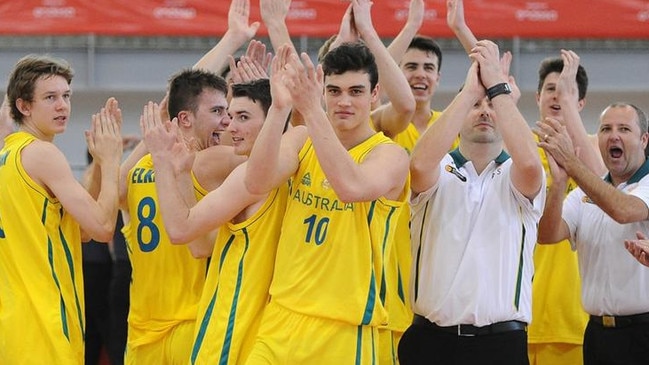
ROCK BOTTOM
Bines has spent the past three years fighting every single day to find another solution, to defeat the pain that not too long ago he felt might conquer him.
Parents Rosie and Glenn and brother Jack have been resolute, while AFLPA-funded therapists and other support have dragged him a long way back from the abyss.
Yet there have been times he has resorted to desperate measures in an attempt to quell the agony.
“I have found myself in times when I knew if I stayed in the spot I was in it was going to kill me,” he said.
“I found myself on every single medication I could to fix it. I tried medical marijuana but I wanted my life back and it wasn’t allowing me to do it.
“I ended up in the injecting rooms in Richmond.
“I would never think about an AFL player going there. I am not a drug user. I hate drugs. My whole sporting career I would never touch it.
“To end up there for pain medication, I already knew I was at the tipping point. You buy your own things (drugs) off the street. I was getting morphine for my neck. I would go 40 hours without sleeping because I was in so much pain and I was going crazy.
“So, I was having morphine and even that wouldn’t take the pain away.
“My whole career I hated drugs and to think I had to be there and resort to that, it is hard for me to even live with that.”
At about that same time he spoke to Voluntary Assisted Dying Victoria, aware his spirit was slowly being crushed by a battle he at that stage did not believe he could win.
“I explained the situation and told them about my quality of life and what I was going through,” he says, in tears for one of many times in an hour-long interview.
“It’s hard to accept. I would rather go out with a bit of dignity than have my parents find a body in a room, which is what it was leading to. I was seriously considering it. It was the medication I was taking.
“It’s just a deadly battle and it’s a hard one but I am a lot better now. My therapist and psych have helped me dramatically. It’s just a day to day battle and a hard one.”
From that rock bottom — his playing weight of 103kg at one stage withered away to 61kg from lying in bed all day — he is now making strong progress.
His mental health is vastly improved and through his work with those experts and Port Melbourne wellness centre Ritual Biohacking he is hopeful one day he might be able to return to study and work in some limited form.
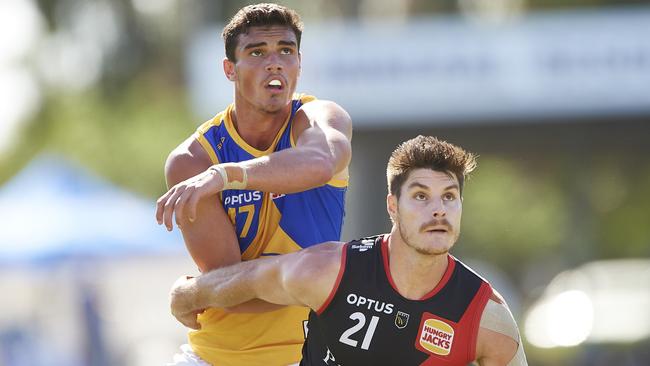
FAILED SYSTEM
If Bines was in many other workplaces or even elite sports the injury that pushed him to drop out of uni, unable to hold down a job, would see him compensated for life.
But like all Australian sportspeople, AFL players have no workers’ compensation.
And as it turns out the total and permanent disfigurement clause in their AFLPA superannuation is totally ill-equipped for so many players.
Concussion campaigner Peter Jess estimates around 1500 players signed up to that scheme over a decade — since updated to a new and improved model — and are only now having claims for concussion, neck and head injuries being knocked back.
Jess says in 2009 the policy specifically excluded all neurological conditions for TPD as the effects of concussions and traumatic brain injuries became apparent in sporting codes.
The AFL’s view is that obtaining workers compensation for all players is an industry-wide challenge with players currently funding the career-ending payouts from their own pockets with an annual contribution.
An AFLPA spokesman said: “Players who leave the game with injuries that impact their ability to work post football, or total or permanent disability deserve to be provided with adequate support. Currently there are gaps in our industry.
“In lieu of WorkCover or support from the league the AFLPA, through the current players’ share of industry revenue, has established an Injury and Hardship Fund and a collective insurance policy for Death or Total and Permanent Disability.
“We continue to advocate for the industry to fill the gaps for players who leave the game in need of support.”
As Morris Blackburn principal lawyer Josh Mennen tells the Herald Sun, the AFL and AFLPA-recommended model was disastrous for many players as the law firm prepares to contest Bines’ non-payment.
The player union changed its policy to Zurich’s OnePath on December 1, 2020.
That OnePath model is more accommodating of claims, but it means players lodging claims for those 11 years are now realising they are not covered.
“The trustee is AMP and they have knocked back his claim,” Mennen said.
“They say it can only be assessed under the activities of daily work definition. It is particularly onerous for claimants to satisfy.
“They need to, for example, be unable to walk or bend to certain specifications. It’s a large deviation from the traditional TPD (total and permanent disability) definition which merely requires the claimant to be unable to work in suitable employment.”
Bines is more frank:
“To get a payout you would need to lose a limb to classify and I don’t know an injury in the AFL where you would lose a limb or have something amputated. It doesn’t make sense.
“There is no workers’ comp, there is no income protection. For people to have their lives so restricted, I just don’t want this to happen to another 18-year-old, a rookie who has their whole life ahead of them and has been chasing it their whole life.
“Then to see how hard our game is. One hit, and that’s your life gone. You put pen to paper (on a superannuation scheme) and you don’t know what it means.
“I bet there is no player out there that knows what their cover is until they are injured and have to chase it, and then they realise there is nothing for them.
“I never want what I have had to go through to happen to anyone else.”
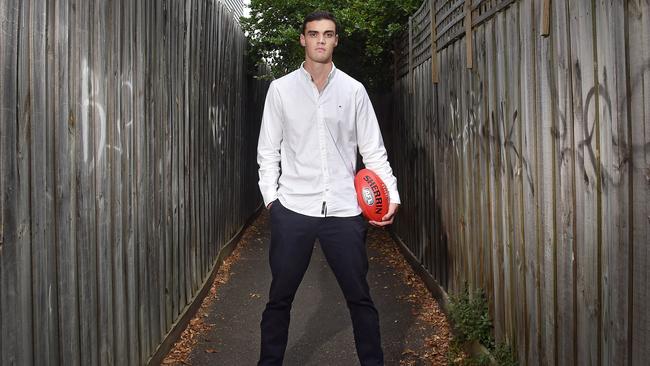
CLASS ACTION
Bines could be part of a class action against AMP and yet realises that would take many years.
Maurice Blackburn’s Mennen is savage in his reflection on the lack of care in the superannuation policy.
“He is clearly permanently disabled to work but that’s not the test he’s being assessed under,” Mennen said.
“Serious questions have to be asked about why young men such as Patrick who are unlikely to have much appreciation of financial matters when they begin their careers find themselves in deeply inferior insurance arrangements. He is not the only player who is having claims rejected under these definitions.
“These types of poor value insurance products have been criticised by the corporate regulator ASIC who went as far as to describe such products as a form of junk insurance.”
Peter Jess has spent years urging the AFL and the player union to find a better superannuation coverage given how ill-suited the 2009-2020 version was for AFL players.
He sent Bines to Maurice Blackburn to forward his claim and believes the AFL has done little to help players despite his own constant warnings about the shortcomings of the insurance.
“It is zombie insurance. There are at least 1500 past players who thought they were covered by this policy and clearly now it has been demonstrated to be a zombie policy. Completely worthless if there is a catastrophic event where you can’t work again,” Jess said.
Bines wants to believe there is some hope for his future.
Improved technology might provide some respite, but despite his improved outlook he knows he will have to live with the pain for many decades.
A true workers’ compensation model for the AFL might not help set him up for life or ease his pain but it will make him realise the battle will be worth something.
“I haven’t worked since my last paycheck in 2019. Every day is different,” he said.
“You can’t plan things. I have good days and I have horrible days. And when I wake up I don’t know which one it’s going to be.
“Which employer will hire someone when there are days you won’t be able to work? So I take it day by day.
“And I haven’t been able to find an answer yet. The doctors say they have tried everything and I will have to live with it for the rest of my life. It is a hard one to accept.
“There has to be a program that is there to support players. Not just for a couple of years but for life. We can’t control when we get injured. We play for our jumper, the club and fans and we hope we get looked after once our career is over.”

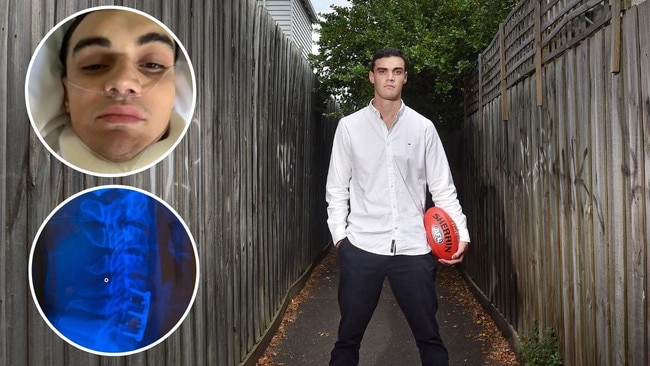
The Rat, Clarko, Dew: Hawks’ Centrals pipeline strikes again
Forty years after a legendary Brownlow medallist arrived, Hawthorn’s deep-seated connection with Central Districts has delivered once more.
GF player ratings: Who starred, flopped in North’s demolition job
There were plenty of contributors to North Melbourne’s record-breaking night, while some Lions had games to forget. See how every player fared on the AFLW’s biggest stage.